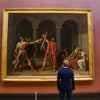The Piccolo Teatro della Città di Milano (translation: "Little Theatre of the City of Milan"; renamed Teatro Grassi) is a theatre in northwest Milan, Italy. Founded in 1947, it is Italy's first permanent theater, and a national "teatro stabile", or permanent repertory company. Piccolo Teatro is considered a theatre of major national and European importance, a "symbol of permanency in Italy". It is located on the Via Rovello just off the Via Dante, between Sforza Castle and the Piazza del Duomo. The theatre has three venues: Sala Grassi; Teatro Studio, which was originally intended to be the theater's rehearsal hall; and Teatro Strehler, which opened in 1998 with a seating capacity of 974. Renamed Teatro Grassi by 2005, its annual calendar consists of approximately thirty performances. In addition, the venue hosts cultural events, from festivals and films, to concerts, conferences, and conventions, as well as supporting the Accademia d'Arte Drammatica.
On 26 January 1947, the Milan municipal council approved the transformation of the cinema Broletto into the Piccolo Teatro, to be managed directly by the City of Milan. The theatre was founded by Paolo Grassi and Giorgio Strehler, along with Mario Apollonio, Virgilio Tosi and Nina Vinchi. According to Grassi, the founders were theatrical and political idealists that sought to "put forward theoretical principles and practical standards of conduct radically different from those which up until then had governed activity in Italy". The first performance, described as minimalist, debuted on May 14, 1947 with L'albergo dei poveri ("Lower Depths") by Maxim Gorky. Offering affordable tickets and productions fraught with risk, the Piccolo Teatro became noted for "revitalizing popular interest in the classics of the Italian stage" while under the guidance of Strehler. Its company became well known for its productions of Carlo Goldoni and Luigi Pirandello in particular, and of Bertold Brecht, Eugene O' Neill, T. S. Eliot, Henrik Ibsen, Molière, Georg Büchner and Peter Weiss.
In the 1960s, the Piccolo Teatro was housed at the Teatro Lirico.Шаблон:Citation needed Giorgio Guazzotti published Teoria e realtà del Piccolo Teatro di Milano ("Myth and Reality of the Piccolo Teatro of Milan") in 1965, another edition followed in 1986. In 1967, the theatre put on a production of Goldoni's Il servitore di due padroni.
Renamed Teatro Grassi in 2005, the theatre's archives are maintained by the Archivio Multimediale del Piccolo Teatro di Milano (AMPT). On the occasion of theatre's sixtieth anniversary in 2007, the President of the Republic, Giorgio Napolitano, granted the "Ente Autonomo Piccolo Teatro di Milano-Teatro d'Europa" patronage for the entire seven-year presidential term. As of 2012, it is under the direction of Sergio Escobar, along with artistic director Luca Ronconi.
In its first decade, performances included:





